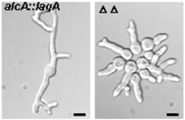Chemistry, Department of: Faculty Series

Liangcheng Du Publications
ORCID IDs
Document Type
Article
Date of this Version
2020
Citation
Molecules 2020, 25, 2286; doi:10.3390/molecules25102286
Abstract
The biocontrol agent Lysobacter enzymogenes OH11 produces several structurally distinct antibiotic compounds, including the antifungal HSAF (Heat Stable Antifungal Factor) and alteramides, along with their 3-dehydroxyl precursors (3-deOH). We previously showed that the 3-hydroxylation is the final step of the biosynthesis and is also a key structural moiety for the antifungal activity. However, the procedure through which OH11 regulates the 3-hydroxylation is still not clear. In OH11, the gene orf3232 was predicted to encode a TetR regulator (LeTetR) with unknown function. Here, we deleted orf3232 and found that the LeTetR mutant produced very little HSAF and alteramides, while the 3-deOH compounds were not significantly affected. The production of HSAF and alteramides was restored in orf3232-complemented mutant. qRT-PCR showed that the deletion of orf3232 impaired the transcription of a putative fatty acid hydroxylase gene, orf2195, but did not directly affect the expression of the HSAF biosynthetic gene cluster (hsaf ). When an enzyme extract from E. coli expressing the fatty acid hydroxylase gene, hsaf -orf7, was added to the LeTetR mutant, the production of HSAF and alteramides increased by 13–14 fold. This study revealed a rare function of the TetR family regulator, which positively controls the final step of the antifungal biosynthesis and thus controls the antifungal activity of the biocontrol agent.


Comments
© 2020 by the authors.